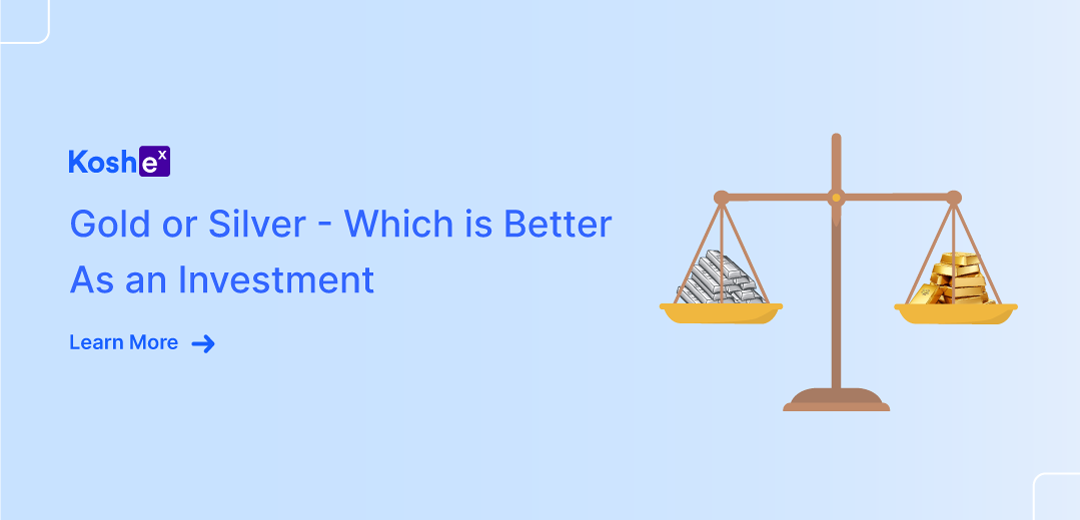In the fast-paced world we live in, it’s important to achieve our short-term goals while also ensuring long-term financial security. As we navigate the complex landscape of personal finance, we may find ourselves asking the question: Is it the right time to switch from equity to debt? In this article, we will explore the nuances of this decision, considering both the potential benefits and important considerations along the way.
Debt funds provide an effective means to safeguard investments, particularly for short-term goals like saving for your child’s education or planning a down payment on a house. Optimizing your investment strategy involves comprehending the mechanics of debt funds and utilizing systematic transfer plans.
At Koshex, we are committed to empowering you with smart savings solutions tailored to your individual needs. We provide hyper-personalized insights and seamless transactions that allow you to make informed decisions. Let’s explore whether switching from equity to debt will align with your financial aspirations.
What are Equity & Debt?
In the dynamic realm of personal finance, understanding equity and debt is crucial. Equity signifies ownership through stocks, while debt involves borrowed capital via loans or bonds. Equity investors own a share of assets and bear risk, while debt requires repayment with fixed interest. Companies balance these financing methods based on risk, return, and financial objectives in their capital structure.
Benefits of Switching from Equity to Debt
Switching from equity to debt is a strategic move that can offer a range of benefits, especially for those seeking a more conservative approach to their investment strategy. It provides a balance between risk and reward, catering to different financial objectives and market conditions.
- Risk Mitigation: Switching from equity to debt can help mitigate risk, as debt investments are generally less volatile compared to equity. This is particularly beneficial for investors looking to safeguard their capital and reduce exposure to market fluctuations.
- Stability in Returns: Debt instruments, such as bonds, offer a steady and predictable stream of income through interest payments. Switching to debt can provide a more stable source of returns, which is advantageous for individuals seeking a reliable income stream.
- Preservation of Capital: Debt funds are designed to prioritize the preservation of capital. This is especially important for short-term financial goals where protecting the initial investment is a priority.
- Suitability for Short-term Goals: If an investor has short-term financial goals, such as saving for a down payment on a house or funding a child’s education, switching to debt provides a more secure avenue for achieving these objectives due to the lower risk profile.
- Interest Rate Sensitivity: Debt investments, including bonds, often respond positively to rising interest rates. Switching to debt during periods of increasing interest rates can potentially result in more attractive returns compared to equity investments.
- Diversification: Including debt in an investment portfolio adds diversification, reducing the overall risk exposure. A well-balanced portfolio with a mix of equity and debt can enhance risk-adjusted returns.
- Market Timing Opportunities: Monitoring market conditions allows for strategic switches. During economic downturns or uncertain market phases, transitioning to debt may offer a defensive strategy to safeguard investments.
- Customization of Risk Exposure: Investors can tailor their risk exposure by adjusting the allocation between equity and debt based on their risk tolerance, financial goals, and market outlook.
- Alignment with Financial Goals: Switching from equity to debt can align investments more closely with specific financial goals, especially those requiring capital preservation, steady income, and lower volatility.
- Systematic Transfer Plans (STPs): Implementing STPs facilitates a gradual shift from equity to debt, enabling investors to optimize returns while minimizing the impact of market volatility.
- Flexibility and Liquidity: Debt investments often provide better liquidity compared to certain equity holdings, offering investors the flexibility to access funds when needed without significant market impact.
The Right Time to Switch from Equity to Debt
Analyzing market trends, interest rates, and economic indicators is essential. During periods of high inflation or rising interest rates, debt funds may offer more attractive returns compared to equity funds.
- Market Analysis: Regularly analyze market trends, interest rates, and economic indicators to stay informed about the financial landscape.
- Inflation Impact: During periods of high inflation, the real value of equity returns may be eroded, making debt funds a more stable option.
- Interest Rate Sensitivity: Rising interest rates can negatively impact equity fund performance, as stock prices may decrease. In contrast, debt funds, especially bonds, may offer more attractive returns.
- Debt Fund Appeal: Debt funds become more appealing during economic uncertainties, thanks to their fixed-income nature and potential for stable returns.
- Preservation of Capital: The stability of debt funds makes them a prudent choice for investors aiming to preserve capital during volatile market conditions.
- Optimizing Returns: Shifting to debt funds in times of high inflation or rising interest rates allows investors to optimize returns and manage risks effectively.
- Strategic Allocation: A thoughtful allocation strategy, considering economic conditions, ensures that the investment portfolio remains resilient and aligned with the investor’s financial goals.
Ways to Switch from Equity to Debt
Systematic Transfer Plans (STPs) serve as a strategic tool for gradually transitioning from equity to debt investments. This approach minimizes the impact of market volatility, providing a smoother transfer of funds over time. STPs enable investors to optimize returns by capitalizing on potential market upswings while mitigating the risks associated with sudden market downturns. By systematically moving investments from higher-risk equity funds to the stability of debt funds, individuals can align their portfolios with their risk tolerance and financial objectives.
Diversification is a key aspect of a successful switch. Balancing the investment portfolio by considering mutual funds, which pool resources to invest in a diversified range of securities, adds a layer of risk management. This approach ensures that the impact of market fluctuations on the overall portfolio is minimized.
Assessing one’s risk appetite is critical during this transition. Equity funds, while potentially offering higher returns, come with increased volatility. Debt funds, on the other hand, provide stability and are better suited for short-term goals or those with a lower risk tolerance. A thoughtful evaluation of risk tolerance and investment horizon guides the optimal allocation between equity and debt investments, contributing to a well-rounded and secure financial strategy.
Conclusion:
Achieving both short-term goals and long-term financial security requires careful consideration of investment strategies. While equity funds offer growth potential over the long term, switching to debt funds can provide stability during critical periods such as saving for your child’s education or preparing for a down payment on a house.
By leveraging debt funds’ stability and employing systematic transfer plans (STPs), you can optimize your investment portfolio while mitigating market risks. It is essential to evaluate market trends, diversify your portfolio, and consider factors such as risk appetite and investment horizon when making investment decisions.
Koshex, with its innovative platform and tailored solutions, empowers you to make informed investment choices.
Sign up with Koshex today and embark on a journey towards financial success.
FAQs:
Q1: What makes debt funds suitable for short-term goals, such as saving for a child’s education?
A1: Debt funds provide stability and lower volatility compared to equity funds, making them ideal for safeguarding and growing savings during critical periods like saving for your child’s education. They offer regular income streams through interest payments while preserving capital.
Q2: How can Koshex help me achieve my financial goals?
A2: Koshex provides a state-of-the-art platform that offers hyper-personalized insights and seamless transactions. By leveraging advanced algorithms and data analysis, Koshex guides your investment decisions, ensuring they align with your specific goals. Sign up with Koshex today to start making informed investment choices.









Leave a Comment